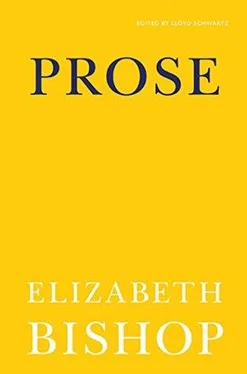It is a very common theory, and, I think, a true one that the substance of a piece of writing defines its form. By this I mean more than classification — essay, story, poem, etc. — the actual shape the writing takes within its particular genre. For example, say, The Return of the Native takes place within the limitations of a year and a day and follows a definite scheme of chorus, action, chorus, action, not because Hardy thought that was an interesting new way of writing a book (although he undoubtedly did), but something in the story itself suggested that form, made it the only possible one for the book. I remember reading quite a while ago an essay by Julian Huxley on “The Size of Living Things.” I have forgotten the scientific reasons or speculations underlying it, but I can remember how strangely it struck me for the first time that although the size of living creatures varies from the germ to the elephant and each species shows variations in itself — yet there is really no danger that I shall ever get much beyond six feet, or stop growing at the size of seven. Even the lobster cannot shrink to crayfish size or ever exceed the capacity of the ordinary lobster pot. Whatever this mysterious regulating power may be, there is another power somehow corresponding to it, and as mysterious in its way, which I believe regulates, or should regulate, the forms of writing. Before a genuine change in form takes place, maybe quite a while before, the actual substance, the protoplasmic make-up of the writing must be changed. A novel can be forced into all sorts of forms (built up from manipulating opposites of preceding forms) just as I could, or the lobster, and yet they would improve it little more than I should be improved by being trained in an S, unless this first inner change had made the forms imperative.
I am saying all this because it will appear that I am attempting to be one of the inventors or discoverers, with a bright idea for doing something but no ideas as to the thing itself. It is presumptuous, but I must ask you to believe that at the back of my mind are the changing ideas which make me want to write on the dimensions for a novel as their result, rather than as an exercise in inventiveness.
I
Mr. T. S. Eliot in his essay “Tradition and Individual Talent” speaks in this way of the individual artist’s duty to the past:
The necessity that he shall conform, that he shall cohere, is not onesided; what happens when a new work of art is created is something that happens simultaneously to all the works of art which preceded it. The existing monuments form an ideal order among themselves, which is modified by the introduction of the new (the really new) work of art among them. The existing order is complete before the new work arrives; for order to persist after the supervention of novelty, the whole existing order must be, if ever so slightly, altered; and so the relations, proportions, values of each work of art toward the whole are readjusted; and this is conformity between the old and the new.
Mr. Eliot is of course speaking of the placing of works of art in their place in the line of tradition, but by changing the subject of the paragraph I find it puts into words, exactly, a certain aspect of the novel. Novels as we know them are still fairly linear; they go along, in some sort of army style; I can think of none to which the march figure could not be applied. We may have halts and retreats and flights in disorder — but that we are moving from one point (usually in time) to another is always certain. The author guides us along this line of march, marshals and directs.
This is Sunday. If I try to think of Friday I cannot recreate Friday pure and simple, exactly as it was. It has been changed for me by the intervening Saturday. A certain piece of work that on Friday I planned to have finished on Saturday I did not finish, so that now looking back from Sunday I discover a certain ironic tinge about Friday evening. Someone came to see me Friday afternoon whom I was delighted to see; but since that time many things have come back to mind and it is impossible to look at the visitor with the eyes of Friday. Saturday will always intervene, and Friday and Saturday will come between me and Thursday. A constant process of adjustment is going on about the past — every ingredient dropped into it from the present must affect the whole.
Now what Mr. Eliot says about the sequence of works of art seems to me to be equally true of the sequence of events or even of pages or paragraphs in a novel. I have mentioned what I call the “march” of the novel, implying movement and a linear sequence to the writing; but I know of no novel which deliberately makes use of this constant readjustment among the members of any sequence. (Perhaps characters occasionally think back over their relationships with one another and reinterpret actions or speeches, but I am speaking here of reinterpretation as an integral part of the whole book, not the proper working out of the story.) It seems almost too simple to say that in the existing novel the ending throws back no light on the beginning, but (excepting of course the rough example of the detective story!) I think it is true. Present events run both forwards and backwards, they cannot be contained in one day or one chapter. All the past forms, to use a musical expression, a frame of reference for the future, and the two combine to define and expand each other. “… for order to persist after the supervention of novelty, the whole existing order must be, if ever so slightly, altered; and so the relations, proportions, values … toward the whole are readjusted; and this is conformity between the old and the new.”
In preparatory school we used to draw diagrams of the “development” of novels on the blackboard. We took for granted that the affairs of a book should grow out of one another; in fact all events which could be explained only by accident or coincidence were rather apologized for, as if they showed some fault in the author. Our diagrams usually rose and fell like so many waves: one alone, a bent line, or possibly a double wave, or, at their subtlest, two waves pursuing each other. This is simplification with a vengeance, of course, but nevertheless the fact that it could be done and would express for us a certain amount of truth about the novel explains somewhat what I have just been saying. I know of no novel which has ever, say, in giving a life history, managed to blur for the reader the childhood of the hero as it would be when he reaches fifty. Joyce’s “moocow” is blurred, but blurred at the age at which he beheld it; when the reader reaches the end of the book he is still in possession of, as of a hard fact, Stephen’s earliest days.
Some attempt has been made to get around this problem by the kind of novel (Proust’s, for example) that picks one moment of observation and shows the whole past in the terminology of that particular moment when the writing is being done. This method achieves, perhaps, the “conformity between the old and the new,” at least one instance of it, but since the conformity itself must be ever-changing, the truth of it, the thing I should like to get at, is the ever-changing expression for it. In conversation we notice how, often, the other person will repeat some word or phrase of ours, perhaps with quite a different meaning, and we in turn will pick up some adjective or adverb of theirs, or even some pun on their words — all unconsciously. This trick of echoes and re-echoes, references and cross-references produces again a kind of “conformity between the old and the new,” and it illustrates fairly well both the situation possible to reveal in the novel and a method of approaching it. The thoughts and symbols which Mrs. Woolf produces over and over again in The Waves have an amazing sameness about them. A symbol might remain the same for a lifetime, but surely its implications shift from one thing to another, come and go, always within relation to that particular tone of the present which called it forth. We live in great whispering galleries, constantly vibrating and humming, or we walk through salons lined with mirrors where the reflections between the narrow walls are limitless, and each present moment reaches immediately and directly the past moments, changing them both. If I were to draw any more diagrams of the development of novels, the lines, although again greatly oversimplified, I am afraid would look something like a bramble bush.
Читать дальше












